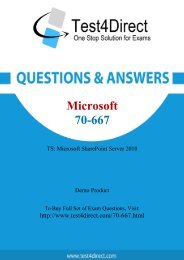Up-to-Date 70-457 Exam BrainDumps for Guaranteed Success
Test4Direct provides latest PDF questions of Microsoft 70-457 exam. You have an opportunity to pass the Microsoft 70-457 exam in one go. Test4Direct is most accurate source to prepare Microsoft 70-457 exam as your success will become site’s responsibility after purchasing 70-457 exam product. There are also lots of discounts and promotion offers that you can avail. Let’s try a free demo http://www.test4direct.com/70-457.html
Test4Direct provides latest PDF questions of Microsoft 70-457 exam. You have an opportunity to pass the Microsoft 70-457 exam in one go. Test4Direct is most accurate source to prepare Microsoft 70-457 exam as your success will become site’s responsibility after purchasing 70-457 exam product. There are also lots of discounts and promotion offers that you can avail. Let’s try a free demo http://www.test4direct.com/70-457.html
Create successful ePaper yourself
Turn your PDF publications into a flip-book with our unique Google optimized e-Paper software.
Microsoft<br />
<strong>70</strong>-<strong>457</strong><br />
Transition Your MCTS on SQL Server 2008 <strong>to</strong> MCSA:<br />
SQL Server 2012<br />
Demo Product<br />
To Buy Full Set of <strong>Exam</strong> Questions, Visit:<br />
http://www.test4direct.com/<strong>70</strong>-<strong>457</strong>.html
Question: 1<br />
You create a table that has the StudentCode, SubjectCode, and Marks columns <strong>to</strong> record mid-year<br />
marks <strong>for</strong> students. The table has marks obtained by 50 students <strong>for</strong> various subjects. You need <strong>to</strong><br />
ensure that the following requirements are met:<br />
• Students must be ranked based on their average marks.<br />
• If one or more students have the same average, incremental ranks must be given based on<br />
the order they are created.<br />
• Ranks must be sequential without gaps in between.<br />
Which Transact-SQL query should you use?<br />
A. SELECT StudentCode as Code,<br />
RANK ( ) OVER (ORDER BY AVG (Marks) DESC) AS Value FROM StudentMarks<br />
GROUP BY StudentCode<br />
B. SELECT Id, Name, Marks, DENSE_RANK () OVER (ORDER BY Marks DESC) AS Rank FROM<br />
StudentMarks<br />
C. SELECT StudentCode as Code,<br />
DENSE_RANK () OVER (ORDER BY AVG (Marks) DESC) AS Value FROM StudentMarks<br />
GROUP BY StudentCode<br />
D. SELECT StudentCode as Code,<br />
NTILE (2) OVER (ORDER BY AVG (Marks) DESC) AS Value FROM StudentMarks<br />
GROUP BY StudentCode<br />
E. SELECT StudentCode AS Code,Marks AS Value<br />
FROM (SELECT StudentCode, Marks AS Marks,<br />
RANK () OVER (PARTITION BY SubjectCode ORDER BY Marks ASC) AS Rank FROM StudentMarks)<br />
tmp WHERE Rank = 1<br />
F. SELECT StudentCode AS Code,Marks AS Value FRCM (<br />
SELECT StudentCode, Marks AS Marks,<br />
RANK() OVER (PARTITION BY SubjectCode ORDER 3Y Marks DESC) AS Rank FRCM StudentMarks)<br />
tmp WHERE Rank = 1<br />
G. SELECT StudentCode AS Code,Marks AS Value FROM<br />
(SELECT StudentCode, Marks AS Marks,<br />
RANK () OVER (PARTITION BY StudentCode ORDER BY Marks ASC) AS Rank FROM StudentMarks)<br />
tmp WHERE Rank = 1<br />
H. SELECT StudentCode AS Code,Marks AS Value FROM<br />
(SELECT StudentCode, Marks AS Marks,<br />
RANXO OVER (PARTITION BY StudentCode ORDER BY Marks DESC) AS Rank FROM StudentMarks)<br />
tmp WHERE Rank = 1<br />
Question: 2<br />
Answer: C<br />
You create a table that has the StudentCode, SubjectCode, and Marks columns <strong>to</strong> record mid-year<br />
marks <strong>for</strong> students. The table has marks obtained by 50 students <strong>for</strong> various subjects. You need <strong>to</strong>
ensure that the following requirements are met:<br />
• Students must be ranked based on their average marks.<br />
• If one or more students have the same average, the same rank must be given <strong>to</strong> these<br />
students.<br />
• Consecutive ranks must be skipped when the same rank is assigned.<br />
Which Transact-SQL query should you use?<br />
A. SELECT StudentCode as Code,<br />
RANK ( ) OVER (ORDER BY AVG (Marks) DESC) AS Value FROM StudentMarks<br />
GROUP BY StudentCode<br />
B. SELECT Id, Name, Marks, DENSE_RANK () OVER (ORDER BY Marks DESC) AS Rank FROM<br />
StudentMarks<br />
C. SELECT StudentCode as Code,<br />
DENSE_RANK () OVER (ORDER BY AVG (Marks) DESC) AS Value FROM StudentMarks<br />
GROUP BY StudentCode<br />
D. SELECT StudentCode as Code,<br />
NTILE (2) OVER (ORDER BY AVG (Marks) DESC) AS Value FROM StudentMarks<br />
GROUP BY StudentCode<br />
E. SELECT StudentCode AS Code,Marks AS Value<br />
FROM (SELECT StudentCode, Marks AS Marks,<br />
RANK () OVER (PARTITION BY SubjectCode ORDER BY Marks ASC) AS Rank FROM StudentMarks)<br />
tmp WHERE Rank = 1<br />
F. SELECT StudentCode AS Code,Marks AS Value FRCM (<br />
SELECT StudentCode, Marks AS Marks,<br />
RANK() OVER (PARTITION BY SubjectCode ORDER 3Y Marks DESC) AS Rank FRCM StudentMarks)<br />
tmp WHERE Rank = 1<br />
G. SELECT StudentCode AS Code,Marks AS Value FROM<br />
(SELECT StudentCode, Marks AS Marks,<br />
RANK () OVER (PARTITION BY StudentCode ORDER BY Marks ASC) AS Rank FROM StudentMarks)<br />
tmp WHERE Rank = 1<br />
H. SELECT StudentCode AS Code,Marks AS Value FROM<br />
(SELECT StudentCode, Marks AS Marks,<br />
RANXO OVER (PARTITION BY StudentCode ORDER BY Marks DESC) AS Rank FROM StudentMarks)<br />
tmp WHERE Rank = 1<br />
Question: 3<br />
Answer: A<br />
You create a table that has the StudentCode, SubjectCode, and Marks columns <strong>to</strong> record mid-year<br />
marks <strong>for</strong> students. The table has marks obtained by 50 students <strong>for</strong> various subjects. You need <strong>to</strong><br />
ensure that the <strong>to</strong>p half of the students arranged by their average marks must be given a rank of 1<br />
and the remaining students must be given a rank of 2. Which Transact-SQL query should you use?<br />
A. SELECT StudentCode as Code,<br />
RANK ( ) OVER (ORDER BY AVG (Marks) DESC) AS Value FROM StudentMarks<br />
GROUP BY StudentCode<br />
B. SELECT Id, Name, Marks, DENSE_RANK () OVER (ORDER BY Marks DESC) AS Rank FROM<br />
StudentMarks<br />
C. SELECT StudentCode as Code,<br />
DENSE_RANK () OVER (ORDER BY AVG (Marks) DESC) AS Value FROM StudentMarks
GROUP BY StudentCode<br />
D. SELECT StudentCode as Code,<br />
NTILE (2) OVER (ORDER BY AVG (Marks) DESC) AS Value FROM StudentMarks<br />
GROUP BY StudentCode<br />
E. SELECT StudentCode AS Code,Marks AS Value<br />
FROM (SELECT StudentCode, Marks AS Marks,<br />
RANK () OVER (PARTITION BY SubjectCode ORDER BY Marks ASC) AS Rank FROM StudentMarks)<br />
tmp WHERE Rank = 1<br />
F. SELECT StudentCode AS Code,Marks AS Value FRCM (<br />
SELECT StudentCode, Marks AS Marks,<br />
RANK() OVER (PARTITION BY SubjectCode ORDER 3Y Marks DESC) AS Rank FRCM StudentMarks)<br />
tmp WHERE Rank = 1<br />
G. SELECT StudentCode AS Code,Marks AS Value FROM<br />
(SELECT StudentCode, Marks AS Marks,<br />
RANK () OVER (PARTITION BY StudentCode ORDER BY Marks ASC) AS Rank FROM StudentMarks)<br />
tmp WHERE Rank = 1<br />
H. SELECT StudentCode AS Code,Marks AS Value FROM<br />
(SELECT StudentCode, Marks AS Marks,<br />
RANXO OVER (PARTITION BY StudentCode ORDER BY Marks DESC) AS Rank FROM StudentMarks)<br />
tmp WHERE Rank = 1<br />
Question: 4<br />
Question: 5<br />
Answer: D<br />
You are developing a database application by using Microsoft SQL Server 2012. You have a query that<br />
runs slower than expected. You need <strong>to</strong> capture execution plans that will include detailed<br />
in<strong>for</strong>mation on missing indexes recommended by the query optimizer. What should you do?<br />
A. Add a HASH hint <strong>to</strong> the query.<br />
B. Add a LOOP hint <strong>to</strong> the query.<br />
C. Add a FORCESEEK hint <strong>to</strong> the query.<br />
D. Add an INCLUDE clause <strong>to</strong> the index.<br />
E. Add a FORCESCAN hint <strong>to</strong> the Attach query.<br />
F. Add a columns<strong>to</strong>re index <strong>to</strong> cover the query.<br />
G. Enable the optimize <strong>for</strong> ad hoc workloads option.<br />
H. Cover the unique clustered index with a columns<strong>to</strong>re index.<br />
I. Include a SET FORCEPLAN ON statement be<strong>for</strong>e you run the query.<br />
J. Include a SET STATISTICS PROFILE ON statement be<strong>for</strong>e you run the query.<br />
K. Include a SET STATISTICS SHOWPLAN_XML ON statement be<strong>for</strong>e you run the query.<br />
L. Include a SET TRANSACTION ISOLATION LEVEL REPEATABLE READ statement be<strong>for</strong>e you run the<br />
query.<br />
M. Include a SET TRANSACTION ISOLATION LEVEL SNAPSHOT statement be<strong>for</strong>e you run the query.<br />
N. Include a SET TRANSACTION ISOLATION LEVEL SERIALIZABLE statement be<strong>for</strong>e you run the query.<br />
Answer: K<br />
You are developing a database application by using Microsoft SQL Server 2012. An application that
uses a database begins <strong>to</strong> run slowly. Your investigation shows the root cause is a query against a<br />
read-only table that has a clustered index. The query returns the following six columns:<br />
• One column in its WHERE clause contained in a non-clustered index<br />
• Four additional columns<br />
• One COUNT (*) column based on a grouping of the four additional columns<br />
You need <strong>to</strong> optimize the statement. What should you do?<br />
A. Add a HASH hint <strong>to</strong> the query.<br />
B. Add a LOOP hint <strong>to</strong> the query.<br />
C. Add a FORCESEEK hint <strong>to</strong> the query.<br />
D. Add an INCLUDE clause <strong>to</strong> the index.<br />
E. Add a FORCESCAN hint <strong>to</strong> the Attach query.<br />
F. Add a columns<strong>to</strong>re index <strong>to</strong> cover the query.<br />
G. Enable the optimize <strong>for</strong> ad hoc workloads option.<br />
H. Cover the unique clustered index with a columns<strong>to</strong>re index.<br />
I. Include a SET FORCEPLAN ON statement be<strong>for</strong>e you run the query.<br />
J. Include a SET STATISTICS PROFILE ON statement be<strong>for</strong>e you run the query.<br />
K. Include a SET STATISTICS SHOWPLAN_XML ON statement be<strong>for</strong>e you run the query.<br />
L. Include a SET TRANSACTION ISOLATION LEVEL REPEATABLE READ statement be<strong>for</strong>e you run the<br />
query.<br />
M. Include a SET TRANSACTION ISOLATION LEVEL SNAPSHOT statement be<strong>for</strong>e you run the query.<br />
N. Include a SET TRANSACTION ISOLATION LEVEL SERIALIZABLE statement be<strong>for</strong>e you run the query.<br />
Answer: F
THANKS FOR TRYING THE DEMO OF OUR PRODUCT<br />
Visit Our Site <strong>to</strong> Purchase the Full Set of Actual <strong>70</strong>-<strong>457</strong> <strong>Exam</strong> Questions With Answers.<br />
http://www.test4direct.com/<strong>70</strong>-<strong>457</strong>.html<br />
We Also Provide Practice <strong>Exam</strong> Software That Simulates Real <strong>Exam</strong> Environment And Has<br />
Many Self-Assessment Features. Download Free Product Demo From:<br />
http://www.test4direct.com/<strong>70</strong>-<strong>457</strong>.html<br />
Money Back Guarantee<br />
Check Out Our Cus<strong>to</strong>mer Testimonials

















